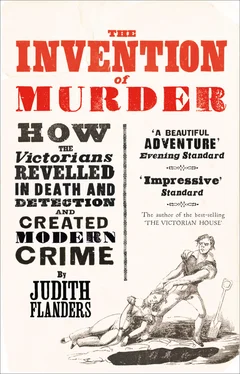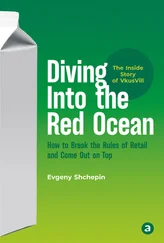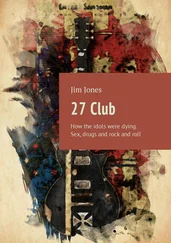Although the police force’s role was officially only preventative, detective work, and forensic science, were beginning to develop. The constable on the beat at Edgware Road, PC Pegler, traced the sacking to a Mr Moseley, a corn chandler in Camberwell. The parish surgeon added his information: the torso was that of a woman, about five feet six inches; her skull had been fractured, and he thought that most probably her eye had been knocked out before death, but the decapitation had been performed after. He judged that the head had been in the water for four or five days. (The parish surgeon in Paddington was less helpful: he reported that the torso had been dead only twenty-four hours, and then added, confusingly, that that meant three or four days.)
Even with this information, nothing further transpired until 20 March, when a man named William Gay provisionally identified the head as that of his sister, Hannah Brown, a washerwoman. Mrs Brown had been engaged to a cabinetmaker named James Greenacre, and they were to marry on Christmas Day, with another cabinetmaker, named Davis, to give her away. Mrs Brown sold off her mangle and laundry equipment, and on Christmas Eve she moved out of her lodgings. Late that night, Greenacre appeared at Davis’s house to tell the family the wedding was off: ‘He had discovered that she was without property, which she had led him to believe she possessed,’ they had ‘had some slight words’, and she had left him. He was ‘much agitated’, but given the circumstances there was nothing odd in that, nor in ‘his having a bundle under his arm. as he might have been providing for his Christmas dinner’. When Mrs Brown failed to appear at the Davises’ that night as expected, they assumed she was embarrassed.
The police asked Davis to view the head, and he agreed it was Mrs Brown. When the police arrived at Greenacre’s lodgings he denied all knowledge of her. A woman named Sarah Gale was living with him, and she seemed to the policeman to be hiding something. He asked to see it, and it turned out to be two rings, a pair of earrings and a pawnbroker’s ticket for two silk dresses, which were identified as Mrs Brown’s, as was the jewellery. In the next room, Sarah Gale’s boxes were found to contain part of a child’s dress which matched the piece of fabric that had been found with the torso. Greenacre and Mrs Gale were both arrested.
Interest was at fever pitch, as was hostility to the two supposed murderers. The Times took the lead in producing a positive waterfall of vicious rumour: that Greenacre had advertised for a wife after Hannah Brown’s death (shades of Corder); that he had murdered his illegitimate child (he didn’t appear to have had one); that he had previously been charged with ‘administering a drug to a female … for the purpose of procuring abortion’ (why, if he was so ready to kill children?); that he had had a boy apprenticed to him for a high fee, then accused him of stealing, so he could discharge him but keep the premium; that there were two more illegitimate children, one of whom he had left at a workhouse door, the other he had ‘made away’ with; that he was one of the Cato Street conspirators (who had planned the mass assassination of the entire cabinet sixteen years before); that he had encouraged someone to kill the Duke of Wellington; and that he had put ‘inflammatory bills’ and ‘the King’s speech, turned upside down’ in his shop windows, signs of incendiary radicalism. A broadside further claimed that Greenacre had made ‘overtures. of a base kind’ to the daughter of a friend, and when she resisted he ‘made a forcible attempt’ on her. His friend protested, and Greenacre in revenge got the man’s son to summons his father, claiming he wasn’t being taught his trade, as set out in his indentures. This was disproved immediately, and the son’s remorse was so great that he ‘did not survive, and died a maniac’. (This beautifully moral story is embellished with a gory picture of Greenacre cutting off Mrs Brown’s head.)
At the magistrates’ hearing, Greenacre said that Mrs Brown ‘had often dropped insinuations in my hearing about her having property enough to enable her to go into business, and that she had said she could command at any time 300l. or 400l. I told her I had made some inquiry about her character and had ascertained that she had been to Smith’s tally-shop [which gave goods on credit] in Long-acre, and tried to procure silk gowns in my name, she put on a feigned laugh, and retaliated by saying she thought I had been deceiving her with respect to my property by misrepresenting it.’ They had been drinking, and he struck her, whereupon she fell off her chair, hit her head and died. At which point, ‘I unfortunately determined on putting her away.’ Then he backtracked: she had arrived at his lodgings already ‘rather fresh from drinking’ and ‘was very aggravating … I own that I tilted the chair with my foot, and she fell with her head against a clump of wood, and appeared insensible; I shook her, and tried to restore her, but she was quite gone.’ His main concern in every statement was to stress that Mrs Gale knew nothing of the matter. She had not been there, and Mrs Brown’s body was gone by the time she returned; he told her they were keeping her belongings in payment of a debt. But both were committed for trial, Greenacre for wilful murder, Mrs Gale as an accessory after the fact. As they left the court, the mob had to be held back by the police: ‘thousands of persons’ followed the coach ‘the whole of the way to Newgate, with the officers of police, their staves out, running by the sides and after the coaches’.
At the trial a surgeon testified that the blow to Mrs Brown’s head had definitely taken place before death, and worse, her eye had also been knocked out before she was dead. Even worse still, ‘the head had been severed from the body while the person was yet alive’. This may or may not have been the case – forensic science was still very basic – but it was generally believed. It took the jury only fifteen minutes to find Greenacre guilty of murder, and Sarah Gale as an accessory.
Soon after his conviction, Greenacre confessed, although he still insisted the death was accidental. He said that he had waved a wooden towel-jack at Mrs Brown, to frighten her, and had inadvertently put out her eye; she fell, and he found she was dead, so he dismembered her to get rid of the body. He took two omnibuses to reach the canal, sitting quietly with the head wrapped up on his lap. He later walked towards the Edgware Road with the torso in a sack until a passing cart gave him a lift some of the way. For the last stage of the journey he said he had taken a hackney cab.
The newspapers fell on these details. The Champion and Weekly Herald, a Chartist paper run by William Cobbett’s two sons (including the one who had supposedly learned to read by keeping up with news of Thurtell), gave all four of its pages to the trial. The Figaro in London satirized the financial bonanza: ‘Greenacre positively established two weekly papers. and it is a well known fact that had this murderous wretch been acquitted, a piece of plate would have been presented to him by the proprietors. for his invaluable services in advancing [their] interests.’ This is a joke, but the idea was valid: four months later the Age was only half-satirical: ‘every line that came from [Greenacre’s] mouth was worth at least threepence’.
Yet Greenacre broadsides were not selling well. One patterer *was wise after the event: ‘Greenacre didn’t sell so well as might have been expected, for such a diabolical out-and-out crime as he committed; but you see he came close after Pegsworth [who murdered a draper over a £1 debt], and that took the beauty off him. Two murderers together is no good to nobody.’ But this didn’t mean no one was interested. While the trial was pending, two men charged sightseers 3d. to see Greenacre’s rooms, especially ‘the arm-chair and block of wood which it was said the unfortunate woman fell on. This sum was readily paid by an immense number of persons.’ Catchpenny works proliferated, including one claiming to be an autobiography (almost certainly a journalist’s confection), and another, the partial title of which was: ‘GREENACRE, OR, THE EDGEWARE-ROAD MURDER. Presenting an Authentic and Circumstantial Account of This most sanguinary outrageof the Laws of Humanity; and Showing, upon the confession of the culprit, the Means he Resorted to, in Order to Effect his bloody purpose; Also his Artful and Fiendlike Method of Mutilating his murdered victim
Читать дальше












